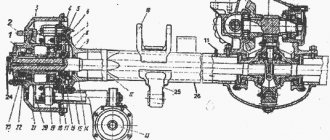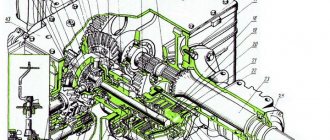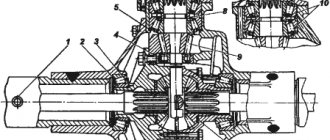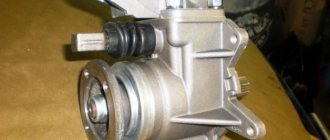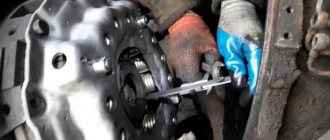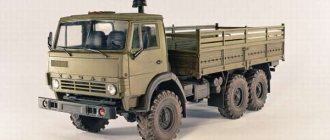Kamaz main gear
The main gear serves to increase torque on the drive wheels and transmit it from the driveshaft to the axle shafts at a right angle.
The constant increase in torque is characterized by the final drive ratio. The total gear ratio of the entire transmission is equal to the product of the gear ratios of the gearbox, transfer case and final drive and can be changed when different gears are engaged. The total gear ratio shows how many times the speed of rotation of the drive wheels is reduced compared to the speed of the engine crankshaft. The higher the gear ratio, the greater the traction force developed on the driving wheels of the car.
Depending on the purpose of KamAZ vehicles, the bridge design provides four options for final drive ratios. Gear ratios 7.22; 6.53; 5.94 are intended for vehicles operating as part of road trains, and the gear ratios are 6.53; 5.94 and 5.43 - for single cars.
KamAZ vehicles use two-stage main gears, consisting of two gear pairs, a pair of bevel gears with helical teeth and a pair of cylindrical helical gears. Changing the gear ratio of the main gear is achieved by installing spur gears with a different number of teeth.
When driving on an uneven road and when turning, the driving wheels of a car travel different lengths of distance in the same periods of time. If the drive wheels were connected to each other by a common shaft, then in all cases of movement they would rotate with the same frequency, which would inevitably lead to slipping and slipping of the wheels relative to the road. Skidding causes increased tire wear, increases power consumption, increases fuel consumption and makes turning difficult.
To avoid these disadvantages, drive axles are equipped with a differential, which allows the drive wheels to rotate at different frequencies relative to each other. However, it should be taken into account that when driving on a slippery road, the presence of a differential contributes to the car skidding.
On KamAZ vehicles, a conical symmetrical cross-axle differential is used in each drive axle. This means that the differential uses bevel gears and the same torques are transmitted to the right and left wheels.
On the intermediate drive axle of KamAZ vehicles with the wheel arrangement: 6X4, a center differential is also installed. It allows the drive shafts of the main gears of the intermediate and rear axles to rotate at different frequencies, and therefore the wheels of these axles can also rotate at different frequencies. The vehicle's center differential is conical, symmetrical, and lockable. When the differential is not locked, it distributes torque almost equally between the main gears of the intermediate and rear drive axles. Differential linkage ensures more uniform loading of drive parts to the drive wheels, reduces tire wear, and improves vehicle handling. However, in difficult conditions and on slippery roads, the presence of a differential negatively affects the vehicle's maneuverability. Under these conditions, it is blocked; the drive shafts of the main gears of the drive axles are rigidly connected and rotate at the same frequencies. At the same time, slipping of the drive wheels is reduced, and the vehicle's cross-country ability increases.
The main drive of the intermediate drive axle of vehicles with Formula 6X4 wheels is equipped with a passageway for driving the main drive of the rear axle. The drive bevel gear 20 (Fig. 1) is installed in the neck of the main gear housing on two bevel roller bearings 24, 26, between the inner races of which there is a spacer sleeve and adjusting washers 25. The splined end of the hub of this gear is connected to the bevel gear of the center differential, and inside Drive shaft 21 passes through the hub, one end connected to the bevel gear of the center differential, and the other, via a cardan transmission, to the drive shaft of the rear axle main gear.
The intermediate shaft rests at one end on two tapered roller bearings 7, between the inner races of which there are adjusting washers 4, and at the other end on a roller bearing installed in the bore of the main gear housing partition. Tapered roller bearings 7 secure the intermediate shaft from displacement in the axial direction. The drive cylindrical gear 3 with oblique teeth is integral with the intermediate shaft. Driven bevel gear 1 is located at the end of the intermediate shaft and is held from turning by a key. The driving and driven bevel gears of the main gear are selected into sets at the factory, ground in and branded, indicating the serial number of the set. The driven cylindrical gear 16, fixed in the cross-axle differential housing, rotates on tapered roller bearings 9. These bearings are adjusted with nuts 8.
Between the halves (cups 1 and the differential housing (Fig. 2.) in the connector plane there is a crosspiece 5, on the spikes of which four bevel satellites 7 are freely mounted, each of which is meshed with two semi-axial gears 4 installed in the differential housing. All gears differential are straight-toothed. The ends of the satellites and their supporting surfaces in the differential housing are spherical, which ensures the necessary centering and correct engagement of the satellites with the axle gears. To reduce friction and the likelihood of scuffing, floating support washers 3 and 2 are installed between the differential housing and the ends of gears 4 and satellites 7.
The washers are selected to a certain thickness when assembling the differential. The drive axle shafts of the drive wheels are connected to the corresponding side gears using splines.
The transmission of torque from the center differential is carried out to the driving bevel gear 20 (see figure), then to the driven bevel gear 1, the driving spur gear 3 and the driven spur gear 16. Torque from the body of the cross-axle differential, to which the driven spur gear 16 is attached main gear is transmitted to the crosspiece 15, and from it through the satellites to the axle gears. Satellites 7 (Fig. 2), acting with equal force on the right and left gears of the axle shafts, create equal torques on them. Moreover, due to the insignificant internal friction, the equality of the moments is practically preserved both when the satellites are stationary and when they rotate. Rotating on the spikes of the cross, the satellites provide the ability to rotate the right and left axle shafts, and therefore the wheels, at different frequencies.
Lubrication of the rubbing surfaces of the main gear and differential parts is carried out by splashing the oil located in the crankcase. Lubricant enters the differential through windows in its housing, and to supply oil to the bevel bearings of the drive bevel gear and the intermediate shaft, longitudinal and radial channels are provided in the cups in which the bearings are installed. The cavity of the main gear housing communicates with the atmosphere through a ventilation cap (breather). The shafts are sealed by self-clamping cuffs protected by mud rings.
In the main gear of the rear axle, the drive bevel gear 21 (Fig. 3) differs from the similar gear of the intermediate axle in that its hub is shorter and has internal splines for connection with the drive shaft 22 of the main gear of the rear axle. Support tapered roller bearings 18 and 20 are interchangeable with the corresponding bearings of the intermediate drive axle. The rear end of the drive shaft of the main transmission of the rear axle rests on one roller bearing installed in the crankcase bore. To circulate lubricant around the bearing, a channel is made in the crankcase neck. The end of the bearing is covered with a cover. The remaining parts of the main drive and cross-axle differential of the intermediate and rear drive axles are similar in design.
autoruk.ru
Replacing wheelsets
Often standard wheels are not enough to overcome serious off-road conditions. When installing special rubber, the main pair is usually replaced. The characteristics of standard wheelsets are designed specifically for the use of factory tires. If you don't replace the wheelsets when switching to larger wheels, they won't last long.
When installing military bridges, the main thing is to be aware of why you need a car. If it was purchased exclusively for off-road use, then a military bridge is the best solution. For a car that will have to be used frequently on the highway, this is not the best choice.
Main drive of KAMAZ middle and rear axle
The KAMAZ main gear is part of the transmission, installed on each of the drive axles, and is designed to enhance torque and redirect it from the driveshaft to the wheels. KAMAZ trucks and tractors are equipped with double gears. Its peculiarity is that it consists of 2 pairs of gears - cylindrical and bevel.
KAMAZ main drive gear ratios can be of four types: 7.22 is suitable for tractors and road trains, 5.43 is used for single trucks, 6.53 and 5.94 have a universal property and are suitable in both cases. Formally, this number means the ratio of the number of gear teeth to the number of gear teeth. Accordingly, the greater this value, the more powerful the traction force of the truck wheels.
Depending on the operating conditions, the appropriate design of the cylindrical wheel is selected: • The KAMAZ main gear has 50 teeth, it is used in mountainous areas for increased traction; • The KAMAZ main gear has 48, 49 teeth, it is quite universal in use, suitable for rough terrain terrain with obstacles;• The KAMAZ main gear has 46, 47 teeth, is used in flat areas and is considered high-speed;• The main gear with 31 and 35 teeth is used on heavyweights KAMAZ 6520 and 6522 for transporting bulk cargo weighing more than 20 tons.
Construction of final drive axles
In the cars of the Kama Automobile Plant, various types of bridges are installed, differing in their design. 6x6 all-wheel drive trucks have three independent drive axles. The design of the front axle on such machines is distinguished by the design of the main gear, rotary mechanism and crankcase.
Do you need a KAMAZ final drive?
On 6x4 all-wheel drive vehicles, the differences boil down to the type of wheel mounting (hub, disc), the presence of inter-wheel locking, and the brake mechanism. They have 2 driving axles - middle (intermediate) and rear. Their structure is almost identical, the main difference is that the main gear of the KAMAZ middle axle is equipped with a lockable center differential. Accordingly, the main gear of the KAMAZ rear axle does not have such a differential. Thanks to this, it is possible to ensure rotation of the drive shafts of the middle and rear axles at different frequencies, minimizing slippage and wheel slipping. In the same way, the cross-axle differential distributes torque to the left and right wheels in the required proportion, so as to prevent slipping on sharp turns and roads with uneven surfaces.
The crankcase is a welded device; flanges are attached to it for attaching support springs, brake mechanisms and rod brackets. Gears are mounted inside the crankcase. The KAMAZ main gear is adjusted using special equipment. As a rule, the tightening degree of the bearings and their engagement on the bevel gears are adjusted. When carrying out service and repair work, the main gear is removed, and adjusting washers of a suitable size are selected for the bearings.
The main gear of the Kama Automobile Plant is a reliable part. However, if the load level is exceeded and there is an error in operation, a number of malfunctions are possible. The main problems that the KAMAZ main gear is exposed to are a high noise level of the drive axle, prolonged knocking of the main gear, damage to the seals and lubricant leakage.
Applicability of final drive to KAMAZ vehicles
If the main transmission of a KAMAZ vehicle cannot be restored and repaired, it is necessary to purchase a new device. It is worth mentioning right away that they are not produced for specific car models, but are divided into several types depending on their applicability: • the old-style main gear is installed on KAMAZ 5320, 5511, 5410 vehicles; • the Euro-style main gear is equipped with new KAMAZ 55111 vehicles , 65115, 53205, 53215; • Euro-type main gear with additional locking is designed for all-terrain vehicles KAMAZ 43114, 43118 and others.
If you doubt your choice, it is better to consult a specialist or an employee of a specialized store. Our specialists will be happy to assist with the selection of gearboxes.
We offer to buy KAMAZ final drive from the manufacturer
Our company sells components and parts for KAMAZ trucks. We offer our clients to buy KAMAZ final drive of original quality from the manufacturer (Naberezhnye Chelny). Direct cooperation with the factory eliminates the possibility of purchasing counterfeits and low-quality products, which means you can ensure reliable and careful operation of your vehicle. The price for KAMAZ main gear in our store is competitive and profitable. Special purchasing conditions apply for trading companies and wholesale buyers. All parts are always in stock, and a well-functioning delivery service is ready to deliver goods to any location in Russia. In some cases, delivery is provided free of charge. All parts are covered by the manufacturer's warranty.
dvigatelkama.ru
GP on rear wheel drive cars
Other types of final drives are installed on rear-wheel drive cars, since the engine and gearbox are parallel to the drive, and torque is supplied to the drive axle vertically.
Rear-wheel drive cars most often have a hypoid gear, which has the least load on the tooth and creates a minimum degree of noise. During operation, the efficiency decreases, since the displaced fastenings of the gear wheels increase the coefficient of friction during sliding.
On cars with a hypoid gearbox, the gear ratio is 3.5 - 5.4, on trucks 5 - 7. This gear differs from a cylindrical gear: the shaft axis does not intersect with the gear, because the shape allows the cardan to be lowered and the body clearance to be reduced, this leads to maximum vehicle stability.
This is interesting: Internal CV joint diagram for Ford Connect, Scorpio, Mondeo
If the car owner is not interested in the size and degree of noise, then a canonical type GP is used. Worm gears are installed very rarely, since their production is labor-intensive and expensive.
For normal functioning of rubbing elements and teeth, lubrication is required. Special oil is poured into the crankcase or rear axle. Its level must be monitored to ensure stable operation of machine elements.
Main drive device KAMAZ 4310
Purpose, design and operation of the main gear
Removing the middle gearbox KAMAZ 55111
Removing the rear gearbox KamAZ 55111
KAMAZ — Rear axle gearbox repair — Part 1 — Disassembly
Installation of the KamAZ 55111 middle gearbox
KAMAZ - Repair of rear axle gearbox - Part 3 - Adjustment of shank bearings
Kamaz Reducer + Half shafts
Repair, adjustment and assembly of Kamaz gearbox
Main gear and differential lock
Transmission
Also see:
- Engine on KAMAZ 6350
- Wiring diagram KAMAZ 53228
- What is Fiskars KAMAZ
- KAMAZ 6520 with an oval body
- KAMAZ master awesome video
- Brake caliper for KAMAZ 4308
- KAMAZ fuel tank volume
- KAMAZ dump truck body lift distributor
- Wheel seal KAMAZ 65115
- Analogue speedometer KAMAZ
- Axle washer KAMAZ 5320
- Towing hook for KAMAZ
- Oil scraper caps KAMAZ
- Wiring diagram KAMAZ 43114 euro 3
- Antifreeze filter KAMAZ
Home » Selections » Final drive device KAMAZ 4310
kamaz136.ru
Classification
These parts are divided based on several design features.
According to the drive mechanism used, they are divided into chain and gear, also called gear drives.
According to the number of pairs of gears involved in meshing, gears are classified into single and double.
Options of the first type include drive and driven bevel gears. Such mechanisms are used on both cars and trucks.
A double gear has a double set of gears. It includes conical and cylindrical parts. This is required to increase the gear ratio, so it is usually used on trucks.
The main gear of the second type can be central or spaced.
In the first case, the mechanism is located in the drive axle housing. There are one- and two-stage options. Two-stage mechanisms provide for changing pairs of gears to vary the torque. These devices are equipped with heavy and tracked vehicles.
The separate transmission is partly installed in the axle, partly in the hub of the drive wheel pair in the form of wheel reducers. Such mechanisms are relevant for SUVs and off-road trucks, as they allow increasing ground clearance.
Also, main gears are classified according to the type of gear engagement into three options.
Depending on the number of axles, through and non-through gears are used. Mechanisms of the first type are equipped with three-axle vehicles with a drive on two axles. For biaxial machines, non-pass options are used.
Based on the type of gear connection, single-type transmissions are classified into cylindrical, worm, hypoid, and canonical.
The first type of transmission has gears with herringbone, straight or oblique teeth. The currently most common front-wheel drive models with a transversely mounted engine are equipped with such mechanisms.
Models with a manual transmission can have up to three input shafts. In this case, each of them is equipped with a drive gear. All of them are connected to one slave.
Among other designs, the most widely used is the hypoid (spiroid) main gear. Its gears have straight or oblique teeth. They can be coaxial or offset up or down. The complex shape of the teeth provides a large meshing area, making this final drive designed for high torque. Consequently, it is used on cars and trucks with a classic layout.
The main gear of the canonical type is characterized by the largest size and noise level.
Worm gears involve a worm transmitting torque to a worm wheel. Based on the location of the worm, they are divided into options with lower and upper placement. In any case, the driven wheel has a large diameter and oblique teeth. And the worm changes in different designs. It can be globoid or cylindrical in shape, right or left in the direction of the thread lines, multi-start or single-start in terms of the number of thread grooves, with an Archimedean, involute or convolute profile in the shape of the thread groove. Worm gears are used extremely rarely due to the labor intensity and high cost of production (usually in multi-axle models with a through final drive and in winches).
Chain-type main drives have two sprockets. The drive is installed on the input shaft of the gearbox, the driven is combined with the hub of the drive wheel. They are used on motorcycles.
The planetary gearbox of bicycles is more complex. It is built into the drive wheel, and the driven sprocket is connected to its gears, and through them to the wheel.
A subtype of chain drive is belt drive. Its difference is the presence of a reinforced timing belt instead of a chain. This mechanism is most often used on scooters and motorcycles with a CVT. Its driven pulley is connected to the hub of the drive wheel, and the variator itself represents the main gear.
Operating principle of manual transmission front-wheel drive - Special equipment
Until recently, cars with a manual transmission, abbreviated as manual transmission, made up the absolute majority among other vehicles with various types of transmissions.
Moreover, a manual (manual) gearbox remains a fairly common device today for changing and transmitting engine torque.
Next, we will talk about how the “mechanics” are structured and work, what the design of a gearbox of this type looks like, as well as what advantages and disadvantages this solution has.
Twin-shaft manual gearbox: design and principle of operation
Having figured out what a gearbox with three shafts consists of, let's move on to two-shaft gearboxes.
This type of gearbox has two shafts: primary and secondary. The primary shaft is driving, the secondary shaft is driven. Gears and synchronizers are attached to the shafts.
Also in the gearbox housing is the main gear and differential.
The drive shaft is responsible for connecting to the clutch, and there is also a gear block on the shaft in rigid engagement with the shaft. The driven shaft is located parallel to the drive shaft, while the gears of the driven shaft are in constant mesh with the gears of the drive shaft, and also rotate freely on the shaft itself.
Let us add that in order to reduce the size of the gearbox, as well as increase the number of gears, in modern gearboxes, instead of one driven shaft, 2 or even 3 shafts can often be installed.
A main gear gear is rigidly fixed to each such shaft, and such a gear is rigidly engaged with the driven gear. It turns out that the design actually implements 3 main gears.
The main gear itself, as well as the differential in the gearbox, transmits torque from the secondary shaft to the drive wheels. At the same time, the differential can also provide such wheel rotation when the drive wheels rotate at different angular speeds.
As for the gear shift mechanism, on twin-shaft gearboxes it is located separately, that is, outside the housing. The box is connected to the switching mechanism by cables or special rods. The most common connection is using cables.
The shift mechanism of the 2-shaft box itself has a lever that is connected by cables to the selection lever and the gear shift lever. These levers are connected to the central shift rod, which also has forks.
If we talk about the principle of operation of a two-shaft manual gearbox, it is similar to the principle of a three-shaft gearbox. The differences lie in how the gear shift mechanism works. In a nutshell, the lever can carry out both longitudinal and transverse movements relative to the axis of the car. During lateral movement, a gear is selected, since the force is applied to the gear selection cable, which affects the gear selection lever.
Next, the lever moves longitudinally, and the force goes to the gear shift cable. The corresponding lever horizontally moves the rod with the forks; the fork on the rod displaces the synchronizer, which leads to blocking of the driven shaft gear.
Finally, we note that manual transmissions of various types also have additional locking devices that prevent two gears from being engaged at the same time or the gear being switched off unexpectedly.
Manual gearbox device how to change gears correctly
All cars with internal combustion engines are certainly equipped with gearboxes.
Any car enthusiast knows how much there is and what types of this device there are, and also accepts the fact that the most common today is a manual transmission. Its short designation is manual transmission. The main difference, in addition to design and indicative ones, is that gear shifting is completely controlled by the driver. Let's take a closer look at what this type of CP is.
Basic faults
- failure of the differential bearing - in gearboxes, bearings are used to allow the differential to rotate. This is the most vulnerable part that operates under critical loads (speed, temperature changes). When the rollers or balls wear out, the bearing emits a hum, the volume of which increases in proportion to the speed of the vehicle. Neglecting timely replacement of the bearing threatens to jam the gears of the main pair, which subsequently leads to the replacement of the entire assembly, including satellites and axle shafts;
- activation of the GP teeth and satellites. The rubbing surfaces of parts are subject to wear; with every hundred thousand kilometers, the teeth of a pair wear out, and the gap between them increases, leading to increased vibration and hum. For this purpose, adjustment of the contact patch is provided by placing spacer washers;
- cutting off the teeth of the gearbox and satellites - occurs if you often drive away with slipping;
- licking of the splined part on the axle shafts and satellites - natural wear and tear according to the mileage of the car;
- turning the axle bushing leads to the fact that the car will stand still in any gear and the gearbox will rotate;
- oil leak - possibly as a result of increased pressure in the differential housing due to a clogged breather or due to a leak in the gearbox cover.
How does the service work?
Gearbox maintenance is rarely done; usually everything is limited to changing the oil. At a mileage of over 150,000 km, the bearing may need to be adjusted, as well as the contact patch between the driven and drive gears
When changing the oil, it is extremely important to clean the cavity from wear products (small chips), as well as dirt. It is not necessary to use flushes for the axle gearbox; it is enough to use 2 liters of diesel fuel and let the unit run at low speeds
Tips on how to extend the performance of the GP and differential:
- change the oil in a timely manner, and if your driving style is more sporty, the car endures high loads (driving at high speed, transporting cargo);
- When changing the oil manufacturer or changing the viscosity, flush the gearbox;
- When driving over 200,000 km, it is recommended to use additives. Why is an additive needed? Molybdenum disulfide, contained in the additive, reduces friction of parts, as a result of which the temperature decreases, the oil retains its properties longer. Remember that if the main pair is heavily worn, there is no point in using an additive;
- Avoid starting with slipping.

